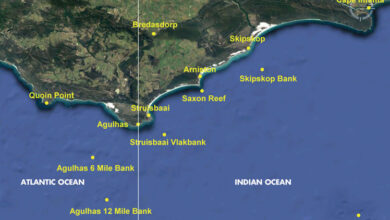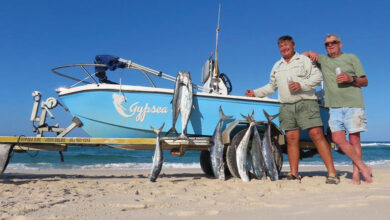Desperately Seeking Tagged Tuna
Keep your eyes peeled for AOTTP tags

(Published in the September/October 2018 issue of Ski-Boat magazine)
By Stewart Norman and Chris Heinecken
IN June 2016 the International Commission for the Conservation of the Atlantic Tunas (ICCAT) initiated the Atlantic Ocean Tropical Tuna Tagging Program (AOTTP) funded by its members and the European Union. The target of the program is to tag a total of 120 000 tunas in the Atlantic Ocean within the next five years — the largest tagging program ever attempted by ICCAT. The information gained through the tag recapture data will help improve and update scientific advice and determine appropriate conservation and management measures in order to achieve sustainable management of coastal state tropical tuna resources.
Fish have been tagged in all areas of the Atlantic (see Figure 1), but so far the only fish recovered in South African waters are those that were also tagged here. That is not to say, however, that we shouldn’t be expecting migratory fish from the tropics to appear in our waters; in fact, the likelihood of this is high.
Although we had a very poor fishing season in RSA last year and the tag team did not achieve their target of 3 000 tags deployed, there is a good chance that the fish tagged elsewhere will migrate into our waters.
As you can see, the number of fish tagged and fish recovered so far during the program is substantial (Table 1). It is just the beginning of the South African tuna fishing season and already we have had five recoveries and are expecting more before the end of the season.
The Awareness and Tag Recovery Program team at CapMarine are seeking tag recovery information from the main ports and landing sites in South Africa, as well as catch reports from the commercial, recreational and charter tuna vessels. The success of the AOTTP is dependent on the reporting of tagged fish once they are caught by commercial and recreational fishermen. So far all recoveries have been reported by commercial fishermen – CapMarine thanks them again for their support.
So far a total of six yellowfin tuna (4.8%) have been recovered in South African waters (at the time of printing). All but one have been recovered by commercial tuna operators in the same approximate area in which they were tagged — about 40 miles west of Cape Town.
On two occasions fish were recovered with internal electronic archival tags in the stomach cavity. Reports from ICCAT indicate that these tags have provided the best data in the history of archival tags deployed in the Atlantic Ocean. The data from these tags includes both vertical and horizontal swimming profiles. The light antenna of the archival tag records the ambient light in the vicinity of the fish, the “track” is deciphered by complicated algorithms involving the timing of the sun rise and sun set and geo-referencing that information to a specific position in the ocean using guesses based on day length, sea temperature and bathymetry.
ICCAT has had some trouble calibrating the data for the electronic tags but can provide realistic information about where the fish has swum since it was tagged. Other data, collected at 15 second intervals, includes internal and ambient temperature as well as pressure (as a proxy for depth). In some cases the tags are only discovered in the factory once the fish has been processed; this is very unfortunate because by this stage the recovery officer, skipper or factory manager is not able to get an accurate fork length (FL) for the fish. This is one of the most important data parameters in the project as it assists with working out growth rates for these incredible fish.
Three of the six tags have been recovered at the same processor — Green Fish Traders — who have been proactive in providing both the tag and information on the recovered fish. You can see in Table 2 that we have managed to get length information for some of the recovered fish but not all. Please keep your eyes peeled for tags if you are targeting yellowfin and record the fork length of the fish (to the nearest cm) as soon as you land it.
If you or your crew find a tagged tuna or hear of anyone who has, please text, WhatsApp, or call +27 63 634 2503 or +27 82 660 6141. This is a dedicated line for reporting tag recaptures. After providing information about the code number of the tag, the length and the area or exact location where the fish was caught, the tag finders will receive AOTTP T-shirts and also a cash reward of R140. The rest of the crew will also receive a T-shirt each. Your name and the name of your boat may be published in follow up articles or in the pamphlets that are being distributed at local boat and ski-boat clubs and at launching and landing sites.
Please note: All fish tagged with red spaghetti tags on the left hand side adjacent to the dorsal fin will also be tagged with chemical or electronic tags and we therefore need the whole fish back to get the full spectrum of biological data. A market-related price will be paid for the fish.





